
A few years ago, I wrote about two distinctive flax wheels, Julia and Jerusha. They are part of an instantly recognizable family, with vase-turned legs, painted rims (usually), star/sunburst/flower stamps, secondary upright supports, and distinctive chip carving. Speculation was that these wheels were made in Connecticut or Rhode Island. Some are unmarked, some marked with the initials JC, IC, or SC.

I am besotted with these wheels and always on the lookout for them. So, my eyes lit up when one came up for auction last September in Rhode Island. The auction was a benefit for the Babcock-Smith House Museum in Westerly. (https://www.babcocksmithhouse.org/). I thought perhaps the museum would have some background on the wheel, but put off contacting them because I was busy and did not have high hopes of getting a response.

I finally shot off an email about a week before the auction. What I thought would be a fruitless email turned out to yield a rich harvest. We still do not know who made these wheels, but what a pleasure the hunt has been.

The museum referred me to one of their trustees, Ellen Madison, who, despite knowing little about spinning wheels and having a packed schedule preparing for the auction, unhesitatingly gave her time and attention to my questions. Ellen found not just one, but two, wheels from the museum’s attic coming up for auction.

The one in the auction photo had a “JC” stamp and the other “IC.”
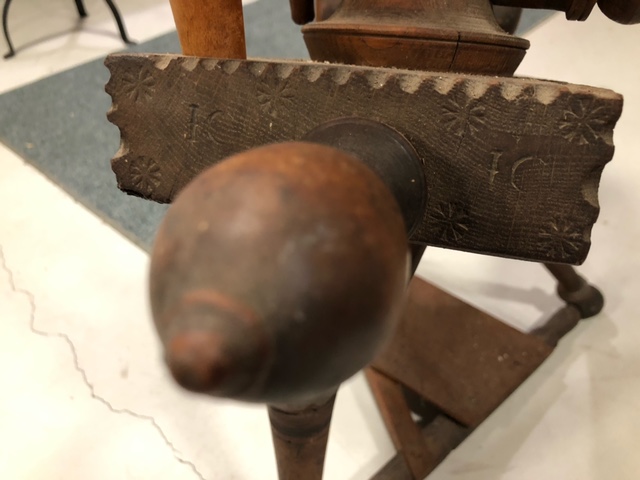
When I explained to Ellen that I “rescued” old wheels, she mentioned her family’s great wheel for which she wanted to find a new home. When she sent me photos of her wheel, I was intrigued.

It was four-legged and tensionless–unusual features for New England great wheels. My interest in the wheel skyrocketed, however, when Ellen wrote that her brother had found initials on the wheel–not just any initials, but a “JC” stamp.
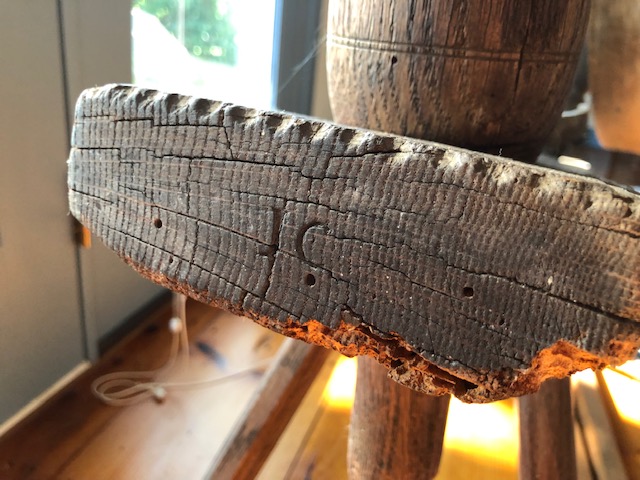
Could this great wheel be by the same maker as the flax wheels? At this point, I decided that I needed to go down to the auction myself and bring home Ellen’s great wheel to add to my collection.

Knowing I would be in Rhode Island, I checked out wheels for sale and did a double take when I saw a great wheel in North Stonington, Connecticut—a town bordering Westerly–that looked identical to Ellen’s. It also had a “JC” maker’s mark. Things were getting exciting. On the day of the auction, a friend, Sue, joined me and Ellen kindly showed us the wheels in the Babcock-Smith house.

There were two wheels on display–an unmarked great wheel looking just like the two “JC” wheels, and an unmarked flax wheel with a family resemblance to the ones from the attic, but with simpler maidens and spokes.
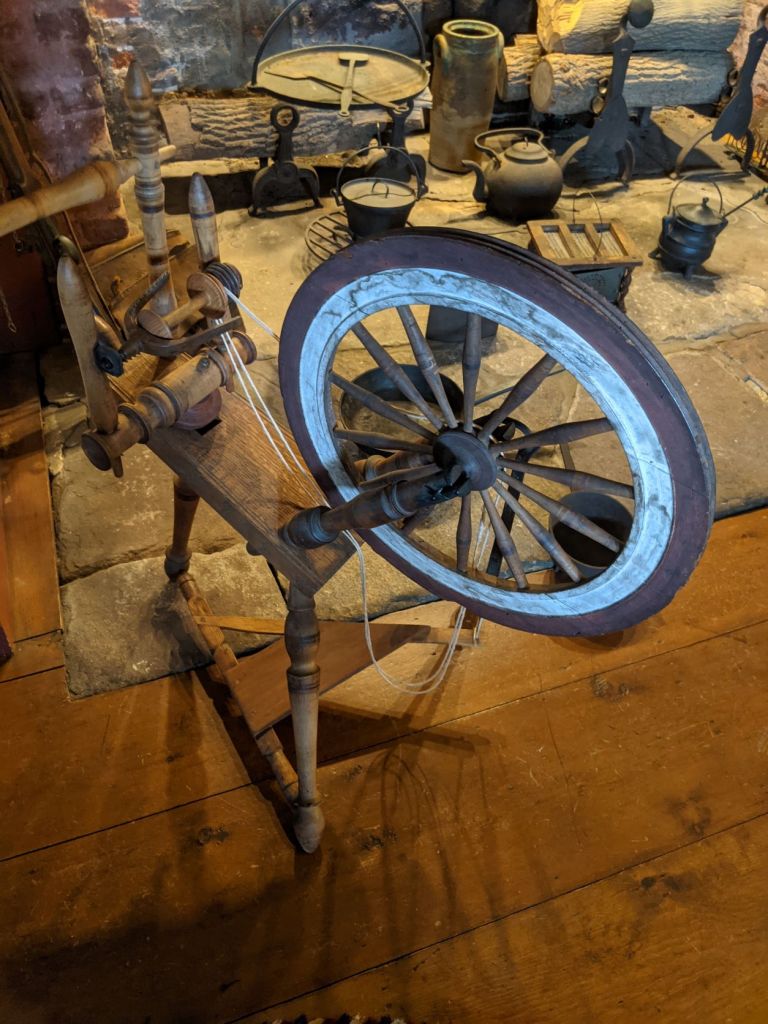

We then perused the auction lots and, to top off the house’s wheel treasure trove, I found a reel with a “JC”—a huge surprise since reels are not often marked.

I bid on the two flax wheels for my friend, Tina, who, like me, is fascinated with these wheels. Sadly, I was outbid, but did win the reel. So, I set out for home the next morning with Ellen’s great wheel, now named “Woody Hill,” and the reel, which I named “Rose.” In the meantime, Sue picked up the North Stonington wheel for Tina. Some months later, Ellen contacted me about a gorgeous wheel that she had spotted at a friend’s house, marked “SC.”

Her friend’s father was a third-generation scrap metal and junk dealer in Westerly, who had an eye for antiques. He had picked up the wheel years earlier, likely in Westerly. When Ellen’s friend decided to sell the wheel, it happily found a home with Tina.
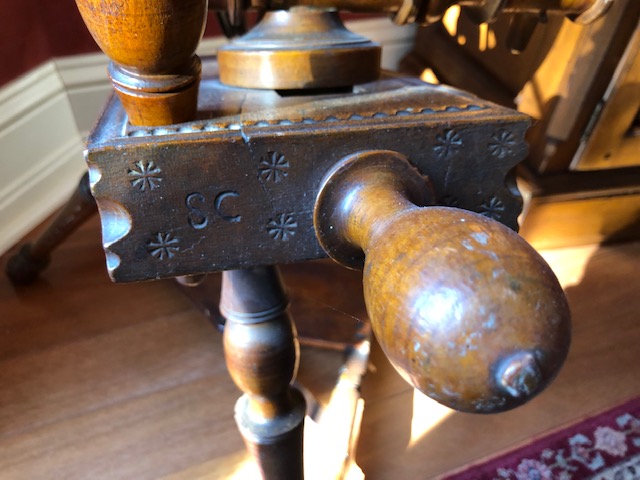
This cluster in Westerly and North Stonington–three great wheels, four flax wheels, and one winder—could not be coincidental, could it? Eight within a ten-mile radius. It seemed as if we were homing in on the area where the wheels had been made. Surely we could track down the maker or family of makers. Ha.

I, and others, spent the next months pursuing every imaginable avenue. There were plenty of likely candidates, namewise, around Westerly and North Stonington—Clarkes, Chapmans, Congdons, Churches, Culvers, Chesebroughs, and more. Some had ties with the Babcock family, some were weavers, some carpenters, but I could not find any definitive links to spinning wheels. I read and read about early Rhode Island, searching for clues.

I dove into different aspects of Rhode Island history, learning about its furniture, weavers, coastal trade, plantation system and slavery, town histories, and early industrialization of spinning and weaving. With Ellen’s help, I tracked down people who might provide leads. I contacted museums, historical societies, authors, professors. All fascinating, but I have not been able to find our wheel makers.
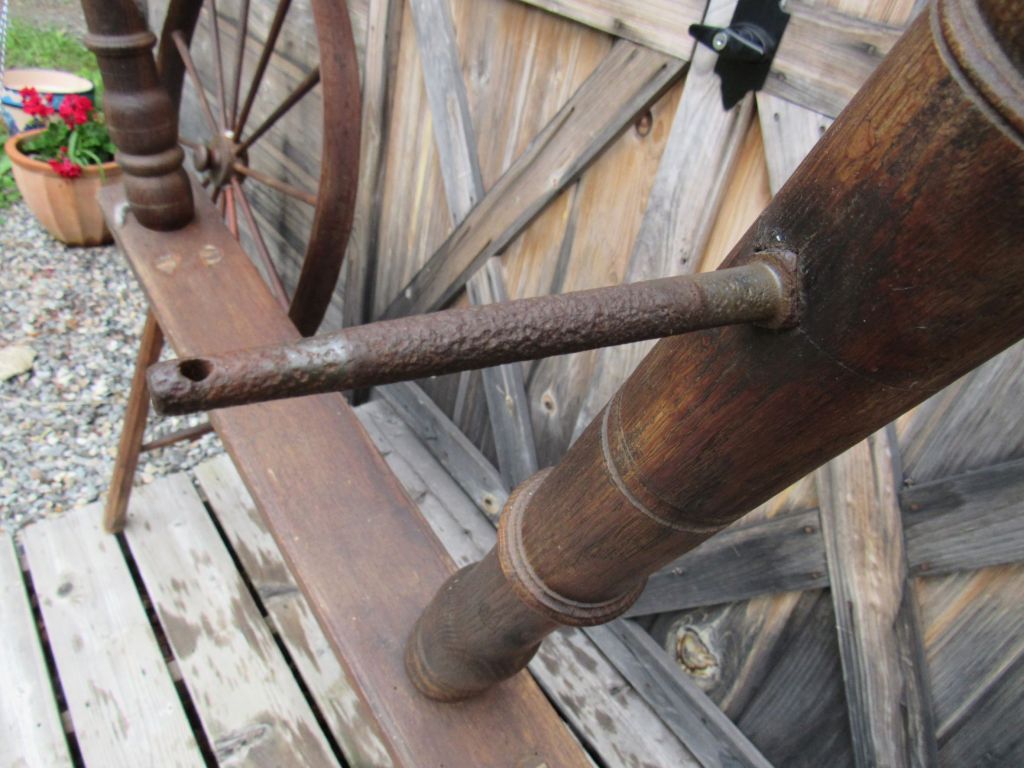
I thought the wheels themselves might provide clues. The flax wheels do not look like other New England wheels. They are more festive, colorful, and elaborate. In fact, the decorative stamps and secondary upright supports running to the legs are features associated with Pennsylvania wheel makers. Similarly, the great wheels do not resemble other New England wheels. With the exception of a small cluster of wheels from the Narragansett, Rhode Island area, four-legged wheels are rare here.
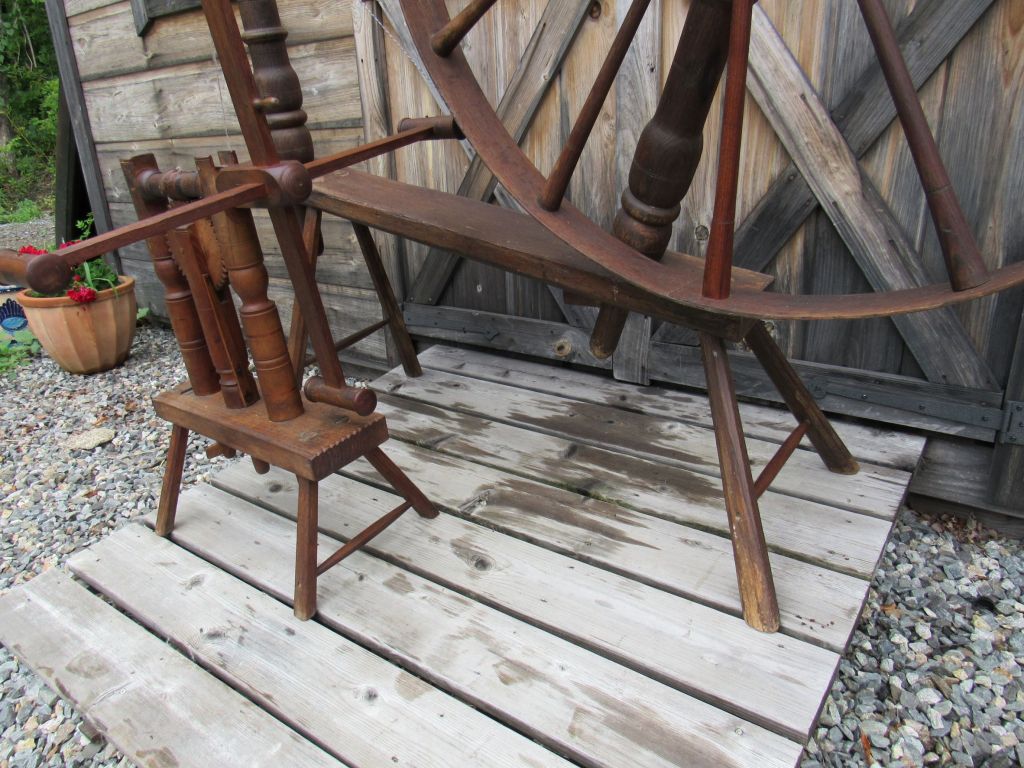
They are usually found in Canada, and very occasionally in the south. Even more unusual is the lack of a tension system, something uncommon even in the south.

But we know that the great wheels have been in the same families for generations and likely were made in the area.
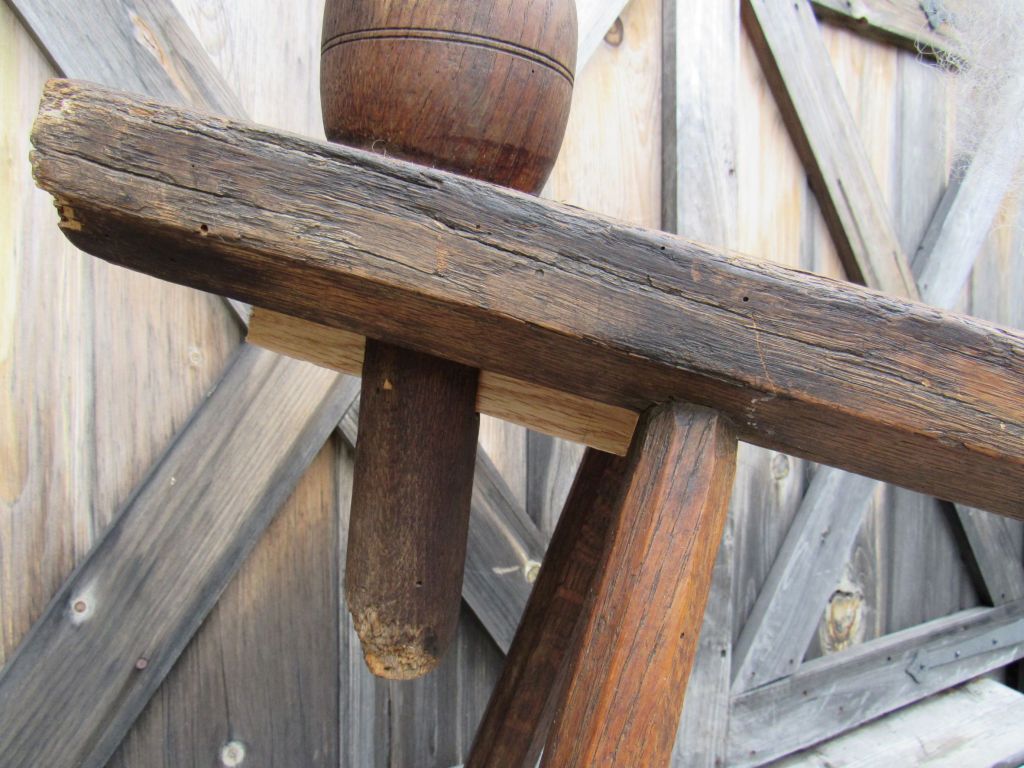
Were the wheel makers involved in Rhode Island’s vibrant coastal trade and influenced by wheels in other areas? And, when were the wheels made?

There has been some thought that the flax wheels may have been produced during the nation’s centennial in the 1870s. The decorative nature of the wheels supports that theory. But most of the flax wheels show heavy use, which likely would not have been the case for centennial celebration wheels, especially in Rhode Island, where industrialized spinning overtook home spinning fairly early in the 1800s.
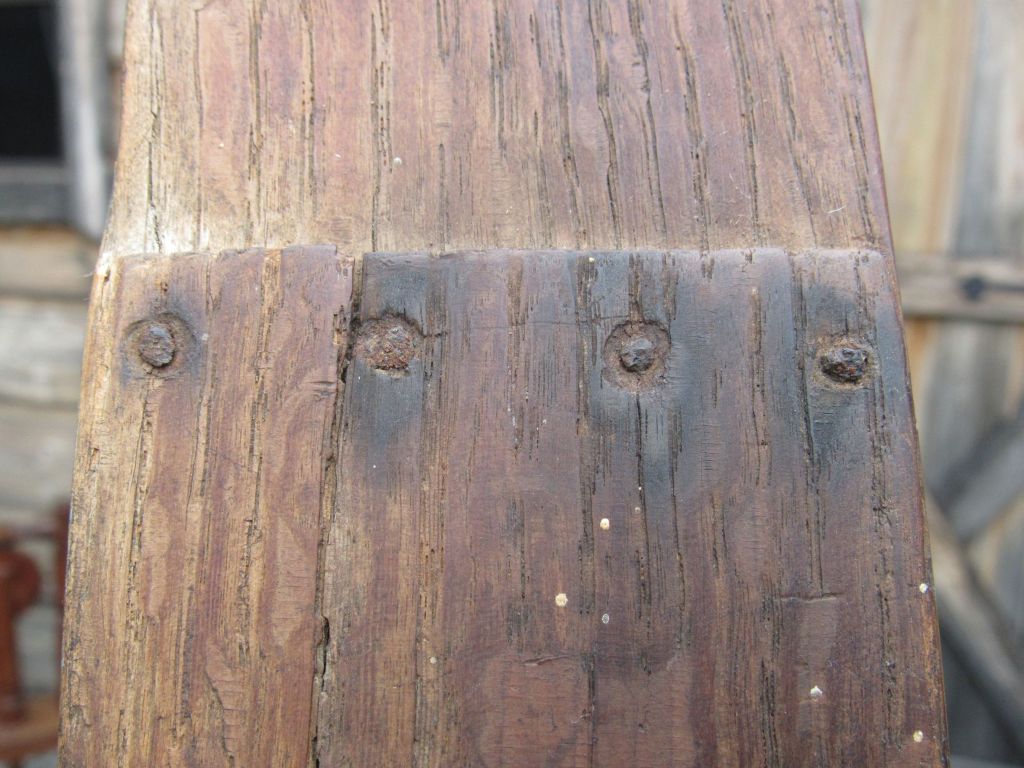
Also, the great wheels in particular, look much older than the 1870s. My thinking, based on the wear, the wheels’ histories, and the area history, is that the wheels likely date from the late 18th century to early 19th century—but it’s just speculation at this point.

We are fortunate to have some history for Ellen’s wheel, Woody Hill. Ellen lives on land that had an 1857 house belonging to Abby Burdick, one of Ellen’s ancestors. In 1819, Gideon Burdick, Abby’s grandfather, was granted a pension for his service in the War of the Revolution, and listed “2 old spinning wheels” as part of his household goods when applying for the pension.
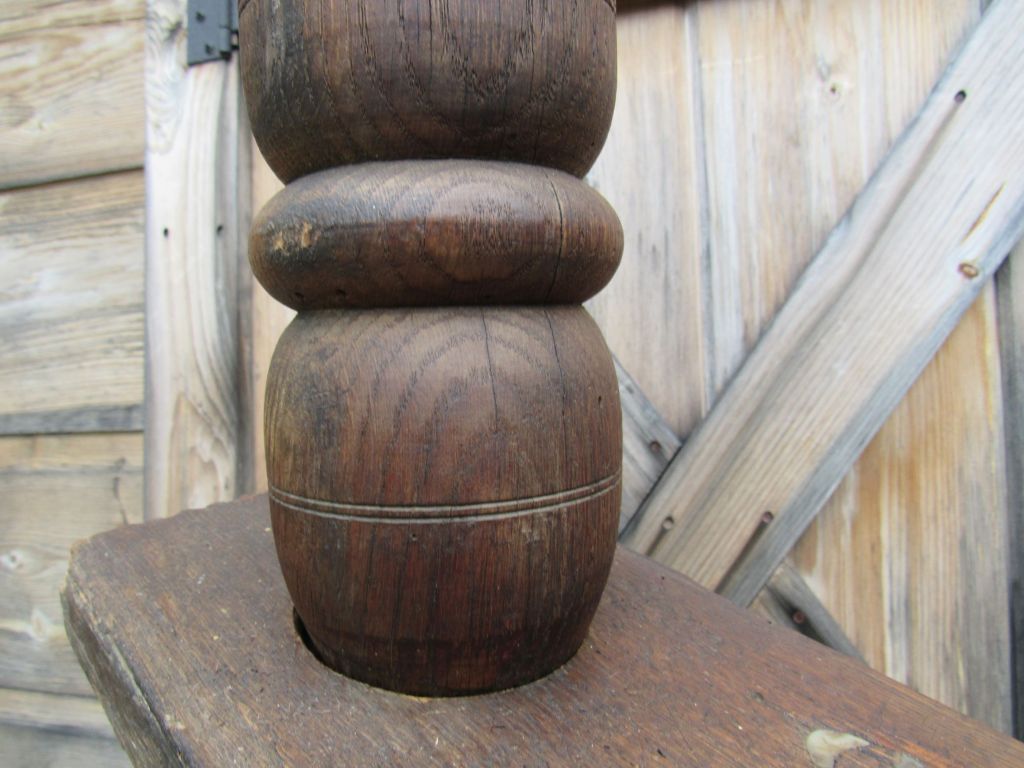
Could those wheels have been passed on to Abby (who lived until 1906) and could one be Woody Hill? In any case, by the early 1900s, Woody Hill was hanging from the rafters of a corncrib on the same land, then belonging to Ellen’s grandfather.

In Ellen’s memory, and the memory of her aunt, born in 1908, the wheel was never taken down from its perch in the rafters. It even survived the legendary 1938 Hurricane, when the corncrib was blown aloft–picked up off its granite posts and landing several feet away. In the 1970s, Ellen rescued the wheel from its corncrib perch when she built her home. Her brother made a bat head for it out of an oar

and her father did an expert job at replacing one of the spokes.

It graced her antique-filled house for decades and now I am honored that her family has entrusted me with this wonderful wheel. If only I could figure out who made it.

So many questions remain unanswered. We do not even know if the great wheels were made by the same “JC” as the flax wheels.

While it appears that the JC mark is the same, at first look, I would not have guessed that the great wheels were made by the same hand as the flax wheels. In contrast with the flax wheels’ elegant turned legs and spokes, the great wheel legs are simply chamfered.

There are no decorative stamps and the spokes are plain.
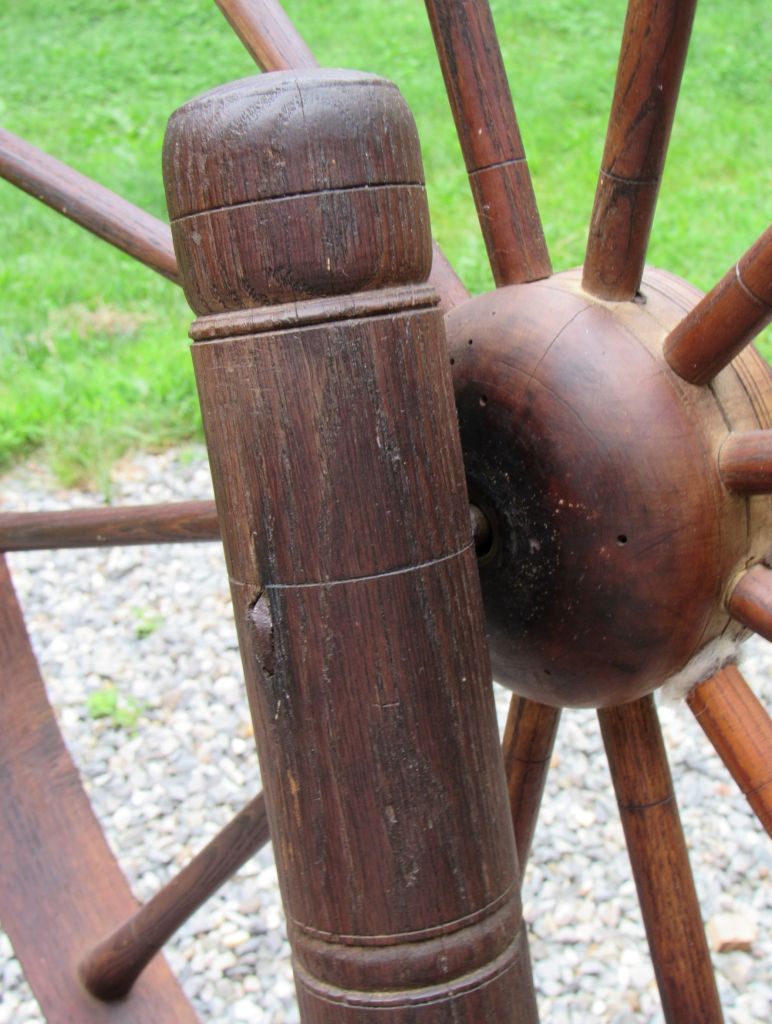
The wheel and spindle supports are turned but are huge and heavy, seemingly built for strength rather than beauty.

Their wood is fairly coarse grained,
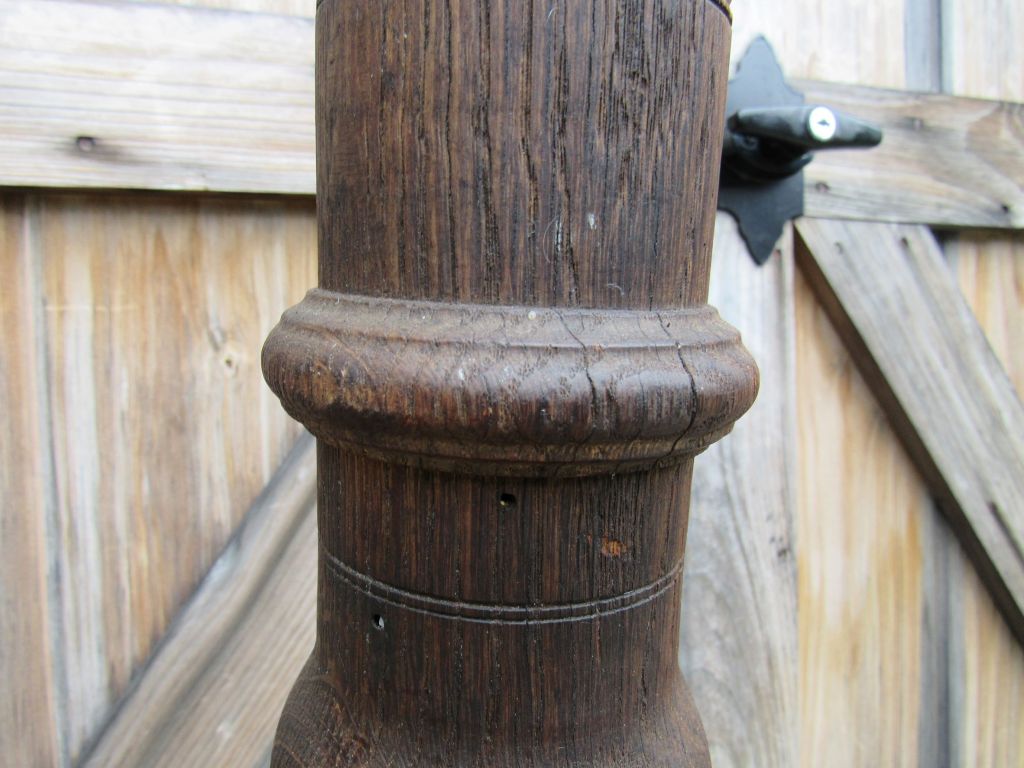
possibly chestnut, with beautiful oak on the drive wheel rim.

In looking closer at Woody Hill and Rose, however, similarities with the flax wheels start to emerge. Rose, the reel, seems almost like a transition piece.

Her table and legs are much like those on the great wheels—almost rustic in feel.

But the upper part was crafted with great precision,

attention to detail,

and an eye for beauty.
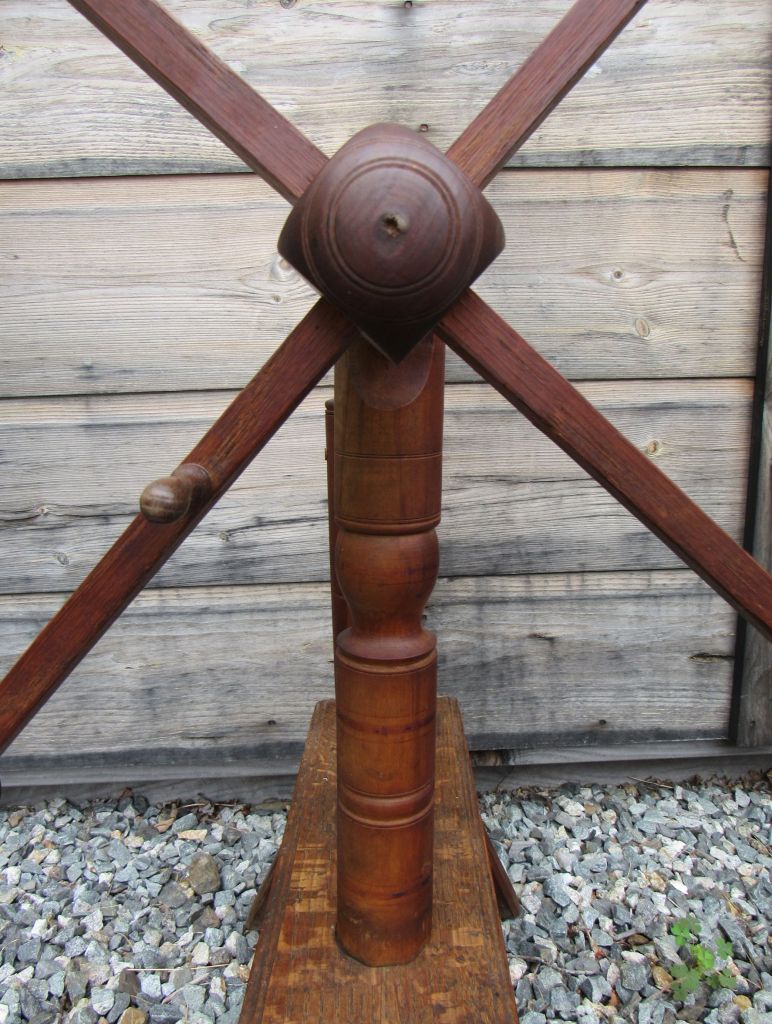
There are dark decorative bands,
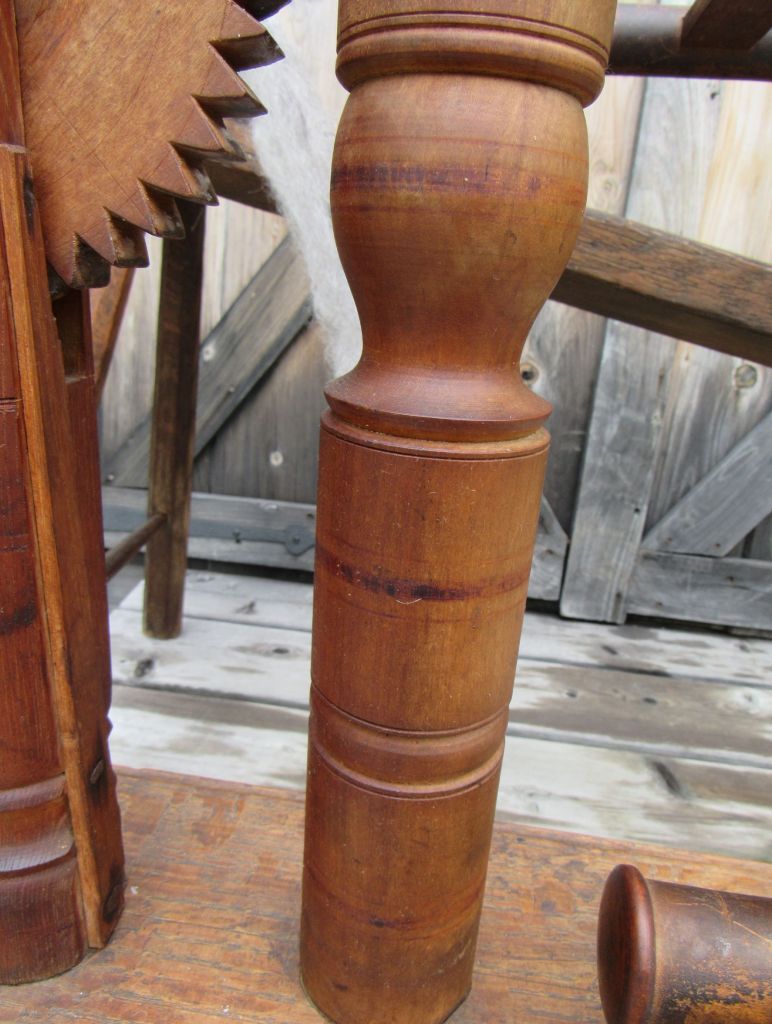
similar to those on the flax wheels, and traces of dark paint (much like the paint on Jerusha) applied selectively,

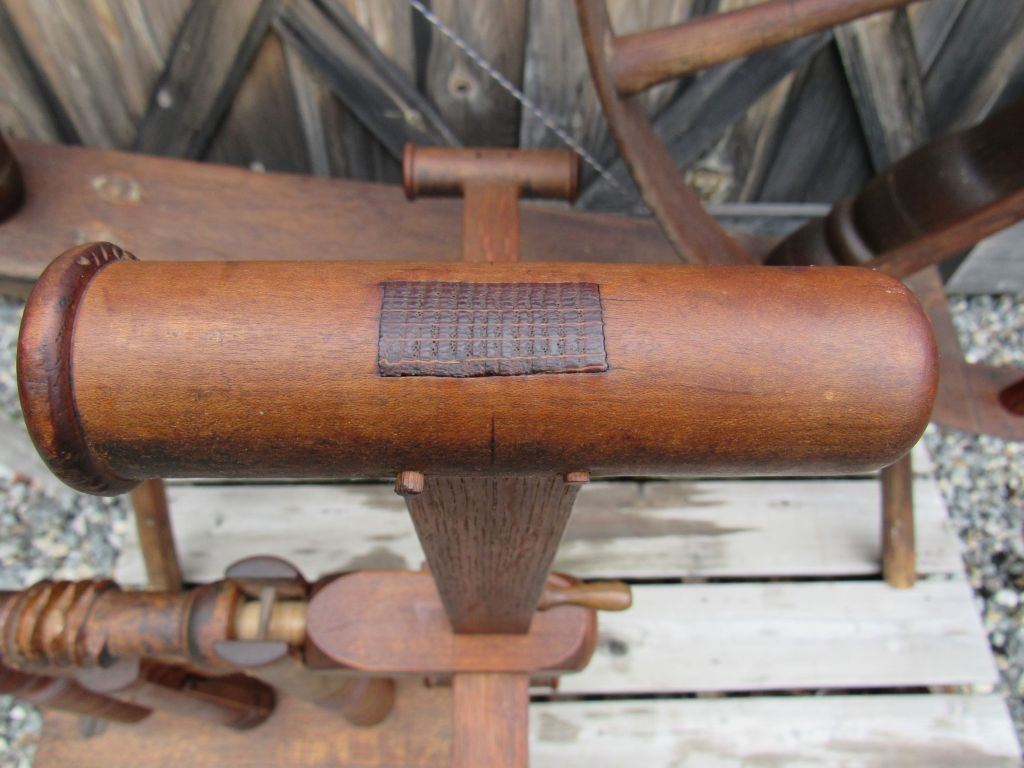
which must have made a lovely contrast with the wood.

The reel has a delicate, finely-made handle for turning the arms.

As with the great wheels, the uprights extend way below the table, with large wedges holding them in place.

All have grooves running down the sides of the tables.
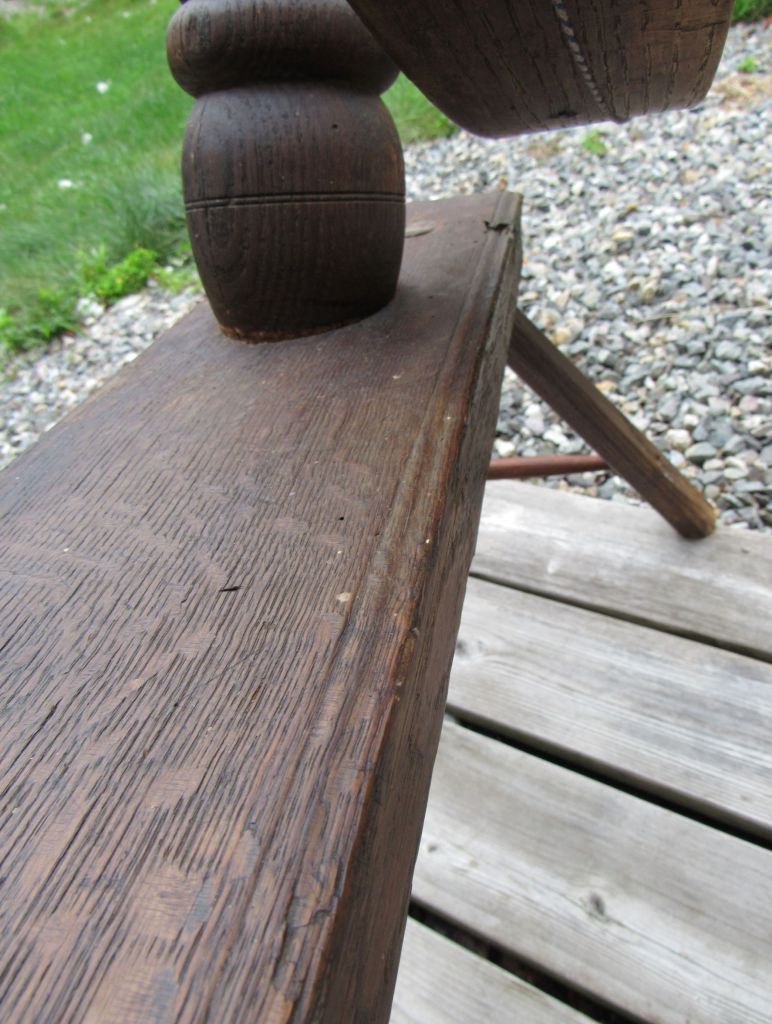


The reel and flax wheels have slightly chamfered underside edges, while Woody Hill’s are pronounced.
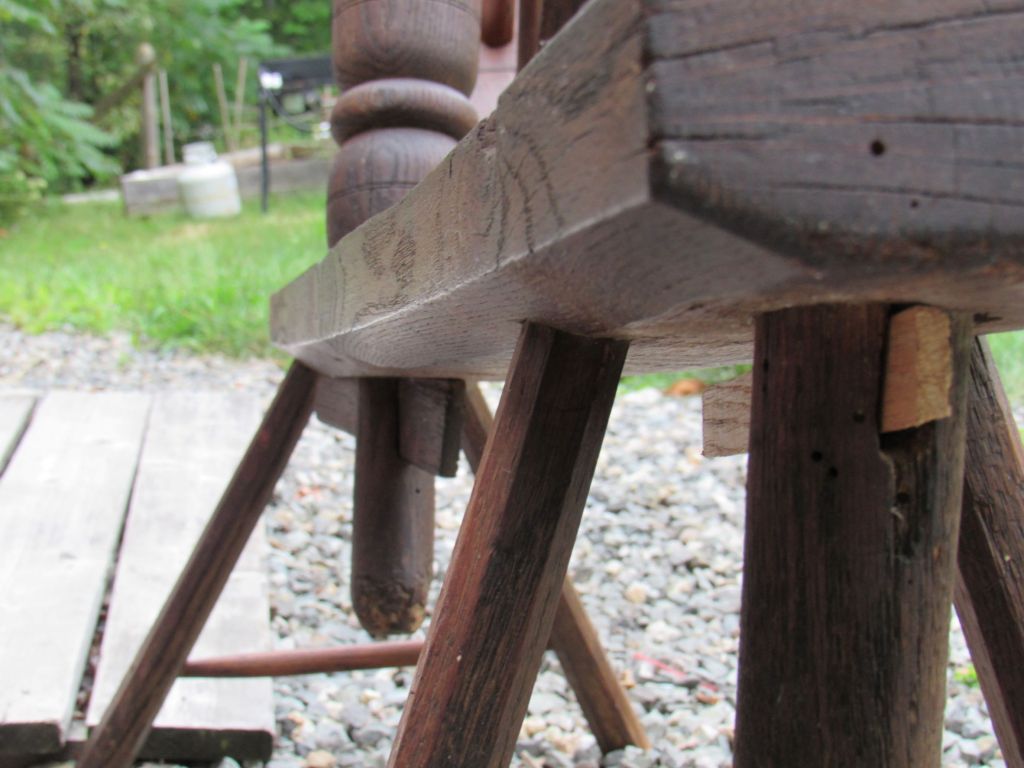
All have some form of chip carving on the ends, with variations.

Whoever the maker was, Woody Hill was made to last.

Aside from some wood-boring beetle damage, its massive posts and sturdy legs survived decades in the corn crib quite nicely.

A few spokes were loose,

with extra nails on the rim and hub showing previous tightening repairs.
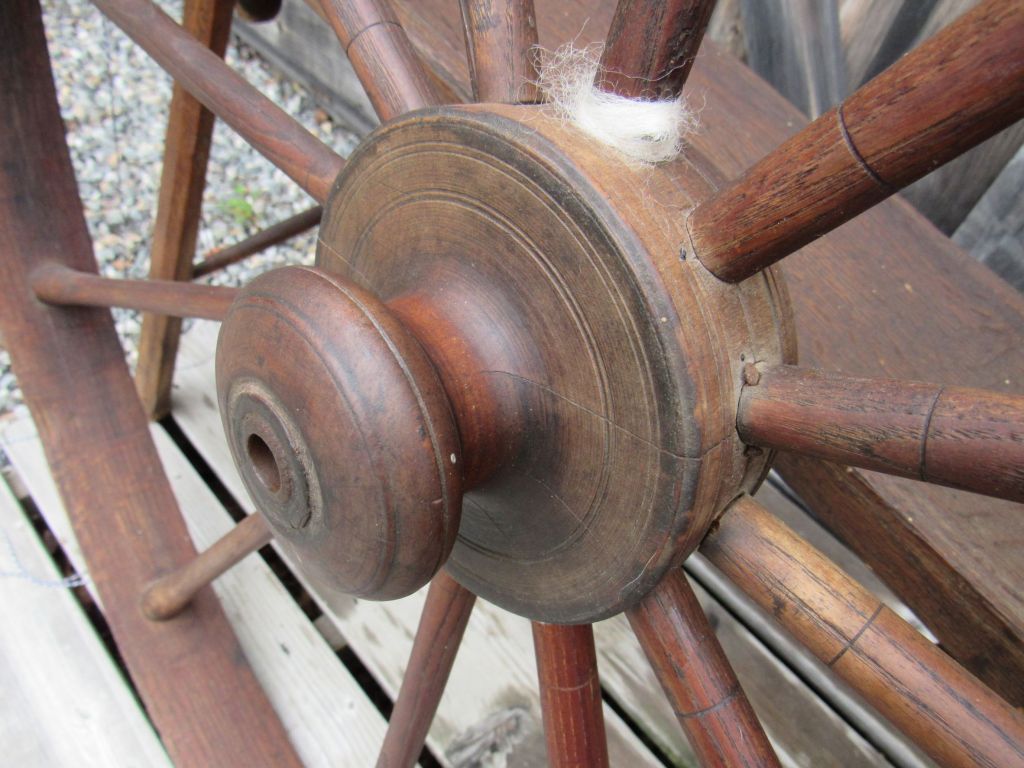
All it took to get it spinning was stuffing some wool around the clattery spokes and finding a bat head that fit.

In no time, Woody Hill was spinning again, with a smooth, easy cadence. Although the posts are massive, the wheel itself is not that large, with a 43 inch rim diameter and relatively small table, 5 3/4 inches wide and 41 1/2 inches long. Its size, weight, and four-legged stance give it a sturdiness that provides a good anchor for spinning.

This is no tippy, band-throwing, temperamental wheel, but a solid legacy of endurance and hard work from those who made and used it.
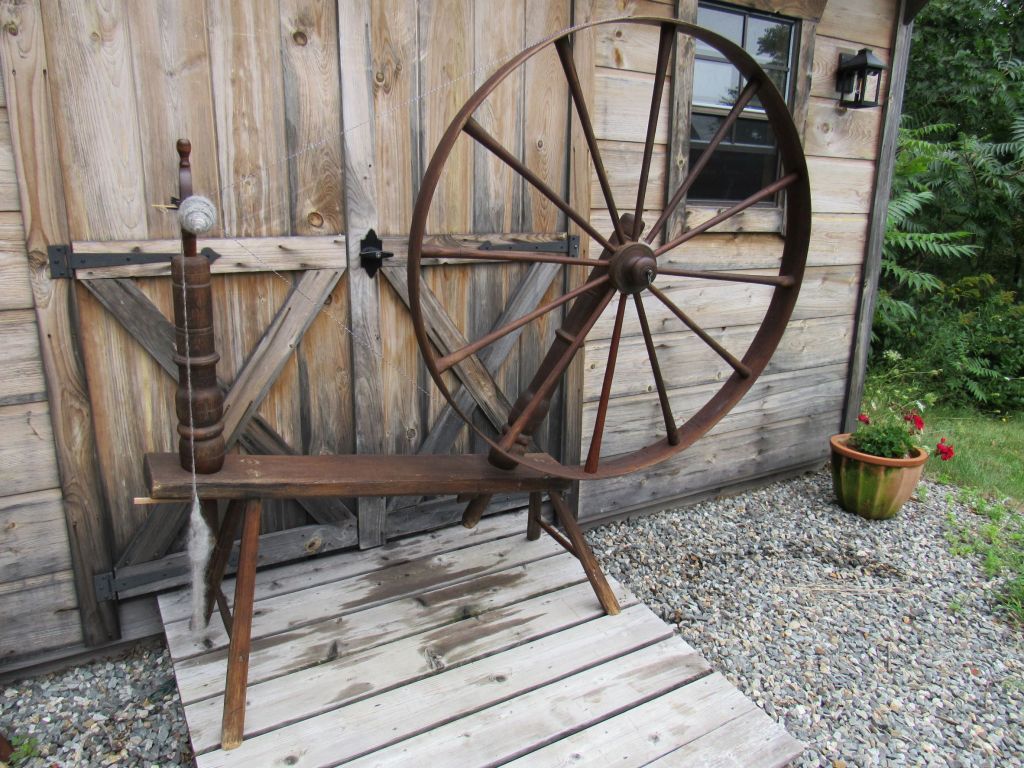
I am taking a break on researching these wheels for now. Perhaps the next step is a visit to the Rhode Island Historical Society. I would like to read the Westerly store accounts of Rowse Babcock, which are housed there. In the 1790s, he was a commission agent for textile outwork, exchanging store goods for spinning and weaving. Perhaps he also sold spinning wheels.
Thank you so much to Ellen Madison for her interest, enthusiasm, generosity, photographs, and help on this journey.

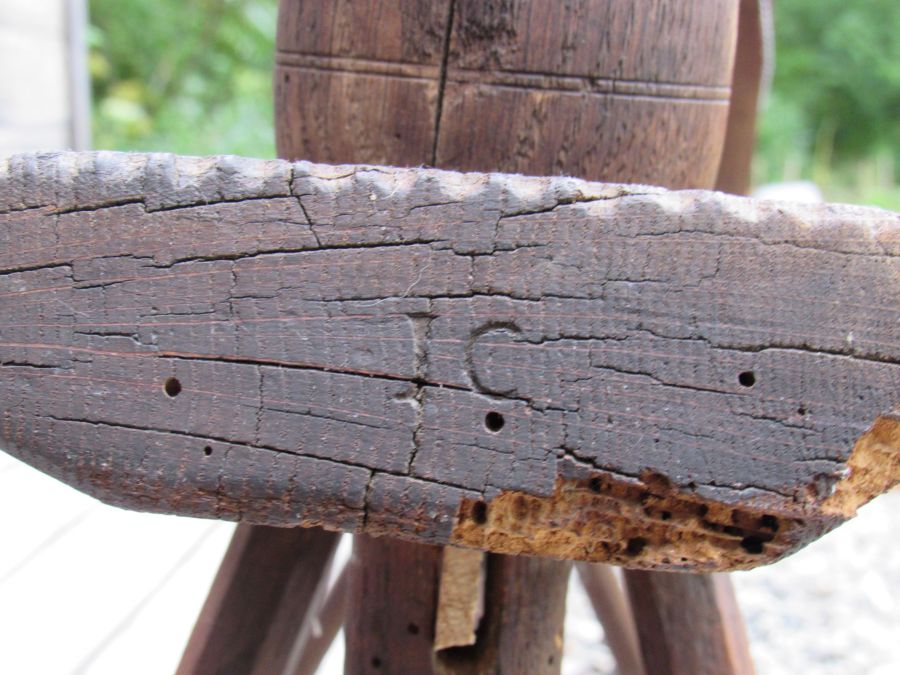
The new retaining wedge in the photo labelled ‘The spindle support is wedged in place under the table’ is perfectly functional. Check out the other wedges in other photos in this blog and you will see a refinement the maker(s) used. The other wedges are angled, wider at one end. This gives more tolerance for a tight fit as joints age and wedges need to be adjusted.
LikeLike
Yes! The other wedges are beautifully made and quite large on this wheel. The new one in the photo you referenced is one that I put in there temporarily, just to hold the upright steady. I will eventually make a nicer one that more closely matches the originals.
LikeLike